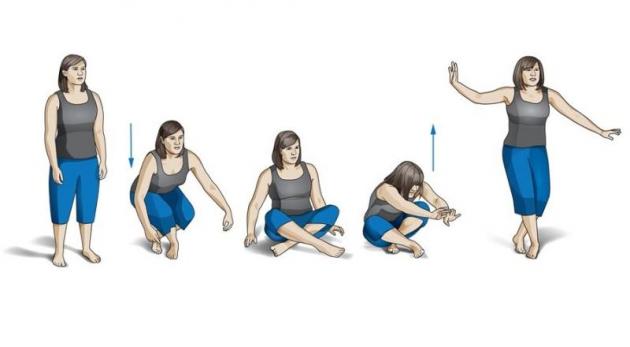If You Fail This Sitting Test, You Probably Don't Have Long To Live
2013.10.25
Here's a way to predict how much longer you'll live in just a few seconds. And all you have to do is follow this simple test at home that involves sitting, standing and repeating.
The sitting-rise test (or SRT) is that it requires no equipment whatsoever and can be performed in seconds. Start by standing upright in the middle of a room. Without using your arms or hands for leverage, carefully squat into a cross-legged sitting position. Once comfortable, try to stand back up from the sitting position without using your arms for help.

The test is scored on a point scale between 1 and 10 (5 points for sitting, 5 more points for standing back up). Each time you use an arm or knee for help in balancing during the test, you subtract one point from 10 possible points. Half a point is subtracted each time you lose balance or perform it clumsily.
Designed by Brazilian physician Claudio Gil Araujo, this test might look like simple feats of balance and strength. But balance and conditioning problems can also increase the risk of dangerous falls and accidents, and also harm cardiovascular health.
After testing it on more than 2,000 of his patients aged 51 to 80. Those who scored less than 8 points on the test were twice as likely to die within the next six years. Those who scored three points or less were five times more likely to die within that same time period.
Since the study was only performed on patients older than 50, the results won't mean the same thing for younger folks. But if you're younger and having trouble with this test, than consider this your wake-up call.
MNN, Discover Magazine
The sitting-rise test (or SRT) is that it requires no equipment whatsoever and can be performed in seconds. Start by standing upright in the middle of a room. Without using your arms or hands for leverage, carefully squat into a cross-legged sitting position. Once comfortable, try to stand back up from the sitting position without using your arms for help.

The test is scored on a point scale between 1 and 10 (5 points for sitting, 5 more points for standing back up). Each time you use an arm or knee for help in balancing during the test, you subtract one point from 10 possible points. Half a point is subtracted each time you lose balance or perform it clumsily.
Designed by Brazilian physician Claudio Gil Araujo, this test might look like simple feats of balance and strength. But balance and conditioning problems can also increase the risk of dangerous falls and accidents, and also harm cardiovascular health.
After testing it on more than 2,000 of his patients aged 51 to 80. Those who scored less than 8 points on the test were twice as likely to die within the next six years. Those who scored three points or less were five times more likely to die within that same time period.
Since the study was only performed on patients older than 50, the results won't mean the same thing for younger folks. But if you're younger and having trouble with this test, than consider this your wake-up call.
MNN, Discover Magazine
More Articles
Copyright © Fooyoh.com All rights reserved.